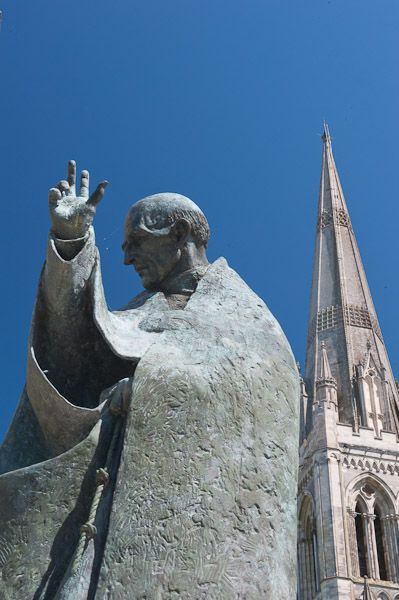
Chichester Cathedral, St. Richard statue
Richard is known by many names, Richard De Wyche, Richard of Droitwich, Richard of Burford, Richard of Backedine, and Richard of Chichester among them. It is the last by which he is more commonly known for he was the Bishop of Chichester in the 13th Century. It is estimated that Richard was born about the year 1197 in Wyche, England (now known as Droitwich), located near Worcester. He was the second son of Richard and alice de Wyche. His father was a land owning squire and he had one older brother and a sister too.
Richard and his siblings were orphaned at an early age. Those entrusted with their care ended up mismanaging their father's estates and squandering what little remained of their fortune. The situation became so bad that when Richard was older, he was forced to give up his studies so that he could help his brother farm his estate and hopefully restore the family's losses. In grateful recognition for Richard's help during this difficult time, his brother offered to turn over all of his lands to him and even arrange for Richard's marriage. Richard humbly refused so that he could continue his studies at Oxford and go on to become a priest. From Oxford, Richard went on to earn degrees in Paris and a doctorate in Bologna.
After completing his studies, Richard returned to England in 1235 where St. Edmund Rich, the Archbishop of Canterbury, and Grosseteste, Bishop of Lincoln both offered him the opportunity to become their Chancellor. Richard accepted St. Edmund's offer and served Edmund faithful even while Edmund was placed in exile in France for opposing Henry III in a contested battle of the rights of Rome over the sovereignty of the king. He remained with Edmund for five years until his death in 1240, whereupon he studied theology with the Dominicans at Orleans and was ordained a priest in 1243. The Dominicans would always bear a special place in Richard's heart for the education he received and for the shelter they provided him during St. Edmund's exile.
After his ordination, Richard returned to England and resumed his position as Chancellor for Canterbury again. He was shortly thereafter elected Bishop of Chichester and was consecrated a year later for his role by Pope Innocent IV on March 5, 1245. Unfortunately with his appointment, Richard found himself in the same bitter struggle with Henry III, as his friend Edmund. With Henry III holding out on releasing the diocese's revenues and property that were due Richard as Bishop of Chichester, Richard was forced to wander his own diocese relying on the generosity of others and those opposed to the King. Richard worked tirelessly during this time to reform his diocese in spite of not even having access to his own Cathedral! He established greater order and reverence to the liturgy in his diocese. He also made tremendous strides in protecting his clergy from abusive knights and others opposed to the Church.
Richard was vindicated in 1247 when Henry finally released the property and funds to Richard. Richard served faithfully in his role as Bishop and vigorously defended the rights of the Church. He loved the poor and the oppressed and refrained from the finery of his office by wearing a hair shirt, and lamb's wool instead of fur. He sold his gold and silver and gave the proceeds to the poor.
Innocent the IV called upon Richard to preach a crusade against the Saracens, and Richard began the arduous journey along the coast of England preaching the crusade. He was overcome by a fever that would prove fatal, leading to his death when he reached Dover. Surrounded by his closest friends, he died at midnight on April 3, 1253 at about 56 years of age and was buried in Chichester Cathedral. His shrine was once a popular devotion until it was destroyed in 1538 under the order of Henry VIII. His remains were most likely thrown away and whatever items of worth that he was buried with were most certainly seized by the crown.
Richard was canonized on January 22, 1262, by Pope Urban IV. He is venerated in both the Catholic and Anglican Church with his feast day celebrated April 3. In England, his feast day is especially observed in the dioceses of Westminster, Birmingham, and Southwark. Richard is the patron saint of coachmen, a once common profession before the modern age and the invention of the automobile. He is often depicted either holding a chalice as he is in our church, or with a chalice on its side at his feet. He is also portrayed kneeling with the chalice before him, working a plough, and as a bishop blessing the people with a chalice nearby.
Legend has it that once when Richard was celebrating Mass, he accidentally knocked his chalice, filled with the precious blood of Christ, to the floor, but not a drop was spilled from the chalice. This is why St. Richard is so often portrayed with a chalice either in his hand or somewhere near his person.
The following prayer was made immensely popular by the play Godspell where it was put to music in the song entitled, "Day by Day."
Thanks be to thee, our Lord Jesus Christ,
for all the benefits which thou hast given us,
for all the pains and insults which thou hast borne for us.
O most merciful Redeemer, Friend, and Brother,
may we know thee more clearly,
love thee more dearly,
and follow thee more nearly. Amen
